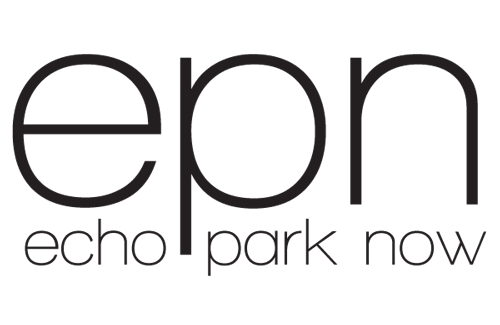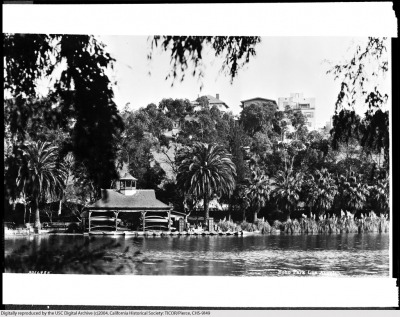Flashback Fridays – Early 20th Century Echo Park Lake
We recently found some photos in the University of Southern California’s Digital Library of Echo Park in the very beginning of the 20th century.
We’ve posted some of the pictures here for your enjoyment. The photo above was accompanied by a lovely account of the beginnings Echo Park Lake written by Jose Rivera.
Initially, the area we now know as the park was a natural arroyo that filled with water from a spring-fed stream that originated at Baxter Street and flowed down what is now Echo Park Avenue. In 1868 the Los Angeles Canal and Reservoir Co. dammed the arroyo to make a reservoir that aided in powering a woolen mill at what is now 6th and Figueroa (then known as Pearl St.) and was to eventually serve local residents, walnut orchards and vineyards to the south along Alvarado. The immigrants that worked these orchards and vineyards settled here and began to build small homes along Sunset Boulevard, between Echo Park Avenue and Lemoyne Street.
In 1875, the woolen mill closed and the reservoir land (then known as the Montana Tract) was sold off. Eventually, Thomas J. Kelley and Dr. W. Lemoyne Wills purchased the land for a business venture. In 1888, Mr. Kelley and Dr. Wills donated the land to the city for the expressed purpose of creating a public park for the enjoyment of the people of Los Angeles.
The first Superintendent of Parks for the city was an English immigrant named Joseph Tomlinson who was assigned the task of creating the park. One day, while overseeing the work, Mr. Tomlinson thought he heard his workers talking during a break, but he knew they were across the park from him. The park had an echo! He knew what the name of the park would be! The park was dedicated and opened to the public in 1895. The famous bed of lotuses that grow in the lake at the northwest end of the park, the largest stand of lotuses outside Asia, is a mystery yet to be solved. One legend says that evangelical Chinese missionaries planted them for use as food, but no one knows the real story. They appeared some time in 1923 or 1924.
Click below to view more photos.




http://www.neighbours.io/members/emborgsaunders7/activity/1928449/
This excellent website definitely has all of the information I needed concerning this subject and didn’t know who to ask.
http://dritter-lernort.de/members/lamontbeebe5/activity/216900/
https://biashara.co.ke/author/emborggalbraith6/
Your style is really unique in comparison to other people I have read stuff from. Thanks for posting when you have the opportunity, Guess I’ll just bookmark this site.
https://www.encarrot.com/author/emborgdevine2/
https://www.seawayads.com/user/profile/28717
http://daf.csulb.edu/cgi-bin/rd.pl?u=http://107.152.47.106/
http://shaboxes.com/author/devineemborg1/
Hello there! I just would like to give you a big thumbs up for the excellent info you have got here on this post. I will be coming back to your web site for more soon.
The very next time I read a blog, I hope that it won’t fail me as much as this one. After all, I know it was my choice to read through, but I genuinely thought you’d have something useful to say. All I hear is a bunch of crying about something that you could fix if you were not too busy seeking attention.
http://supersoapbox.com/members/mcphersonemborg9/activity/124292/
Spot on with this write-up, I absolutely believe that this web site needs much more attention. I’ll probably be returning to see more, thanks for the info!
http://www.criosystem.it/project/cof-rivenditore-ufficiale/
http://worldteam.donate2dogsports.org/members/saunderssaunders7/activity/169937/
http://www.sicipiscine.it/index.php?option=com_k2&view=itemlist&task=user&id=67551
http://reliablerealestateinc.com/members/lamontdevine3/activity/230190/
http://csvt.in/index.php?option=com_k2&view=itemlist&task=user&id=715674
I’d like to thank you for the efforts you’ve put in writing this blog. I’m hoping to see the same high-grade content by you in the future as well. In truth, your creative writing abilities has inspired me to get my own, personal website now 😉
I used to be able to find good advice from your content.
http://hobbyglass.ru/index.php?option=com_k2&view=itemlist&task=user&id=77066
http://hobbyglass.ru/index.php?option=com_k2&view=itemlist&task=user&id=77066
Saved as a favorite, I really like your web site!
http://seksgrappen.nl/index.php/2015/10/17/later-als-ik-groot-ben/
http://www.associazioneridere.it/index.php?option=com_k2&view=itemlist&task=user&id=1609370
http://www.cooplareggia.it/index.php?option=com_k2&view=itemlist&task=user&id=4536559
http://onuraydogdu.com/Soru-Cevap/index.php?qa=user&qa_1=galbraithgalbraith1
http://thaifixing.com/author/kristiansenmcpherson2/
http://mtc-ye.net/index.php?option=com_k2&view=itemlist&task=user&id=152254
http://sualaptop365.edu.vn/members/kristiansenlamont8.353682/
http://cedcollegepark.com/site/index.php/component/users//index.php?option=com_k2&view=itemlist&task=user&id=722744
https://www.wazzy.com/user/profile/26933
http://gitlab.asap.um.maine.edu/devinemcpherson0
http://www.palsuniversity.org/members/laniermcpherson3/activity/148258/
http://www.sicipiscine.it/index.php?option=com_k2&view=itemlist&task=user&id=67551
https://answers.informer.com/index.php?qa=user&qa_1=hildebrandtfields5465
https://www.slando.sk/user/profile/37874
Everyone loves it when people get together and share ideas. Great website, keep it up!
http://kosmoturizm.ru/chto-predstavlyayut-lyudi-pod-slovom-buduschee-kto-to-predstavlyaet-kak-chelovechestvo-raskinulos-na-neskolko-galaktik-i-srazhaetsya-s-drugimi-civilizaciyami18749/
http://www.vaticanroom.it/index.php?option=com_k2&view=itemlist&task=user&id=1138476
http://cedcollegepark.com/site/index.php/component/users//index.php?option=com_k2&view=itemlist&task=user&id=722744
https://www.gaiaonline.com/profiles/devinegalbraith9/44547636/
https://www.deenaar.com/index.php?page=user&action=pub_profile&id=714618
http://www.chimisal.it/index.php?option=com_k2&view=itemlist&task=user&id=974371
http://als.anits.edu.in/members/beebesaunders89/
http://www.tuscancountrystore.com/index.php?option=com_k2&view=itemlist&task=user&id=1614235
http://0009.in/user/profile/32577
http://www.alexandraetco.ca/ma-to-do-list-pour-preparer-noel-sans-stress/noel-chien-preparation-fetes-lumieres-alexandra-co/
https://www.slando.sk/user/profile/37874
https://ilbarattoweb.it/author/galbraithdevine1/